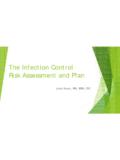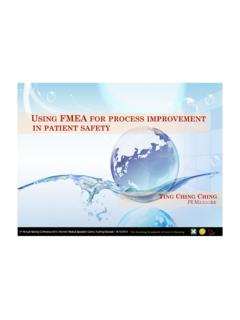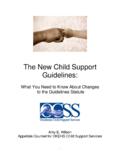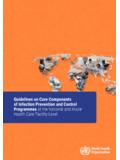Transcription of WHO Surgical Site Infection Prevention Guidelines …
1 Page 1 of 44 WHO Surgical site Infection Prevention Guidelines Web Appendix 1 Overview of available relevant Guidelines on Surgical site Infection Prevention Three comprehensive national Guidelines have been published over the past 5 years on the Prevention of SSI (1-3). The Guidelines issued in 1999 by the CDC (4) have been updated recently, but they have not yet been published (5). In addition, 2 Guidelines (6, 7) and one systematic review (8) have been published on Surgical antibiotic prophylaxis. All published Guidelines are from high-income countries. The United States Institute of Health Improvement (9, 10), the United Kingdom Department of Health (11) and Health Protection Scotland (12) have also introduced care bundles for the Prevention of SSI. A care bundle is a set of key evidence-based interventions that improve patient care and outcome when used together. However, unlike Guidelines , the SSI care bundles have not undergone a systematic review. A summary of recommendations from various SSI Guidelines and care bundles are presented in web Appendices 2-27, respectively.
2 For the purpose of this review, we have analysed Guidelines published since 2011 by the UK-based National Institute for Health and Care Excellence (NICE) (2), the Society for Healthcare Epidemiology of America (SHEA)/Infectious Diseases Society of America (IDSA) (1), The Royal College of Physicians of Ireland (3) and the unpublished CDC draft version of the update (5). In 2012, the European Union project entitled Prevention of hospital infections by intervention and training (PROHIBIT) analysed all available Guidelines for the Prevention of SSI and found a considerable variation among European countries (13). In summary, 12 of 21 countries had a single document defining their individual recommendations for specific measures related to the Prevention of SSI. Of the remaining 9 countries, between 2 and 4 separate documents were used to cover most preventive measures. Three countries had a separate document on air quality in the OR and 5 countries had a separate document for preoperative antibiotic prophylaxis.
3 The systematic review performed for the WHO report on the burden of endemic HAI worldwide clearly indicated that SSI is a major source of morbidity and mortality (14) . Furthermore, the summary of SSI Guidelines presented here (see Table ) showed that some key factors with an impact on SSI are not addressed and clearly identified a need for the development of global Guidelines . As a result, systematic reviews of 27 topics related to SSI Prevention have been conducted to allow the WHO GDG to make clear recommendations based on an in-depth analysis of the Page 2 of 44 sources and strength of the available evidence. Page 3 of 44 Table Summary of Guidelines by topic TOPICS WHO 2016 SHEA/IDSA 2014 NICE* 2008/2013 RCSI 2012 PREOPERATIVE Preoperative bathing/showering Yes Conditional recommendation, moderate to very low quality of evidence It is good clinical practice for patients to bathe or shower prior to surgery. Either plain soap or an antiseptic soap may be used for this purpose.
4 Due to very low quality evidence, the panel decided not to formulate a recommendation the use of chlorhexidine gluconate (CHG) cloths for the purpose of reducing Surgical site Infection (SSI).We suggest not using CHG cloths for the purpose of reducing SSI. Unresolved issue Reduces microbial load, but no definite proof that it reduces SSI. Yes The benefits of preoperative bathing or showering with antiseptics for the Prevention of SSI appear to be uncertain. Evidence for the most effective type of antiseptic wash also appears to be inconclusive and further research is needed. Yes (1B) Wash the patient/ensure that the patient has showered (or bathed/washed if unable to shower) on day of or day before surgery. Page 4 of 44 TOPICS WHO 2016 SHEA/IDSA 2014 NICE* 2008/2013 RCSI 2012 PREOPERATIVE Hair removal Avoid Strong recommendation, moderate quality of evidence In patients undergoing any Surgical procedure, hair should either not be removed or, if absolutely necessary, should be removed only with a clipper.
5 Shaving is strongly discouraged at all times, whether preoperatively or in the operating room. Avoid: II Do not remove unless hair will interfere with the operation. If hair removal is necessary, remove outside the operating room by clipping. Avoid Evidence for preoperative hair removal in reducing SSI rates is insufficient. If hair removal is necessary, then clipping may be associated with a reduced rate of Infection . Avoid: 1A Avoid hair removal at the Surgical site . If hair must be removed, use single-patient use clippers and not razors. Page 5 of 44 TOPICS WHO 2016 SHEA/IDSA 2014 NICE* 2008/2013 RCSI 2012 PREOPERATIVE Screening and decolonization for Staphylococcus aureus Strong recommendation, moderate quality of evidence. The panel recommends that patients undergoing cardiothoracic and orthopaedic surgery with known nasal carriage of S. aureus should receive perioperative intranasal applications of mupirocin 2% ointment with or without a combination of CHG body wash.
6 Conditional recommendation, moderate quality of evidence . II Screen for S. aureus and decolonize Surgical patients with an anti-staphylococcal agent in the preoperative setting for high-risk procedures, including some orthopaedic and cardiothoracic procedures - - Page 6 of 44 TOPICS WHO 2016 SHEA/IDSA 2014 NICE* 2008/2013 RCSI 2012 PREOPERATIVE The panel suggests considering to treat also patients with known nasal carriage of S. aureus undergoing other types of surgery with perioperative intranasal applications of mupirocin 2% ointment with or without a combination of CHG body wash. Surgical antibiotic prophylaxis Yes Strong recommendation, low quality of evidence When indicated (depending on the type of operation), Surgical antibiotic prophylaxis should be administered prior to the Surgical incision. I Administer only when indicated. I Administer within 1 hour of incision to maximize tissue concentration. Yes Antibiotic prophylaxis should not be used routinely for clean non-prosthetic uncomplicated surgery.
7 When antibiotic prophylaxis is needed, a single dose of antibiotic intravenously on starting anaesthesia should be considered. However, prophylaxis should be given earlier for operations in which a tourniquet is used. Yes: 1A Single dose only unless otherwise indicated. Give an additional dose of antibiotic if the Surgical procedure is prolonged or there is major intraoperative blood loss (> L in adults or 25mL/kg in children). Ensure that the antibiotic is given at induction (within 60 minutes before skin incision). Page 7 of 44 TOPICS WHO 2016 SHEA/IDSA 2014 NICE* 2008/2013 RCSI 2012 PREOPERATIVE Yes Strong recommendation, moderate quality of evidence. Surgical antibiotic prophylaxis should be administered within 120 minutes before incision, while considering the half-life of the antibiotic. II Stop agent within 24 hours after the procedure for all procedures. Evidence suggests that administering antibiotics after rather than before, tourniquet inflation may be associated with a reduced rate of SSI, but further research is needed.
8 In surgery where a tourniquet is to be applied, a 15-minute period is required between the end of antibiotic administration, and tourniquet application. Smoking cessation - I Encourage smoking cessation within 30 days of procedure. - - TOPICS WHO SHEA/IDSA NICE* RCSI Page 8 of 44 2016 2014 2008/2013 2012 PREOPERATIVE Preoperative infections - I Identify and treat infections (for example, urinary tract Infection ) remote to the Surgical site prior to elective surgery. Do not routinely treat colonization or contamination. - - Extended-spectrum beta-lactamase colonization No recommendation. Due to the lack of evidence, the panel decided not to formulate a recommendation. TOPICS WHO SHEA/IDSA NICE* RCSI Page 9 of 44 2016 2014 2008/2013 2012 Corticosteroid or immunosuppressive medication Conditional recommendation, very low quality of evidence The panel suggests not to discontinue immunosuppressive medication prior to surgery for the purpose of preventing SSI.
9 III Avoid immunosuppressive medication in the perioperative period if possible - - TOPICS WHO 2016 SHEA/IDSA 2014 NICE* 2008/2013 RCSI 2012 Page 10 of 44 Nutrition Conditional recommendation, very low quality of evidence The panel suggests considering the administration of oral or enteral multiple-nutrient enhanced nutritional formulas for the purpose of preventing SSI in underweight patients who undergo major Surgical operations. I Do not routinely delay surgery to provide parenteral nutrition. Hypoalbuminemia: no recommendation. Although a noted risk factor, do not delay surgery for the use of total parenteral nutrition. - - TOPICS WHO 2016 SHEA/IDSA 2014 NICE* 2008/2013 RCSI 2012 Page 11 of 44 Mechanical bowel preparation Conditional recommendation, moderate quality of evidence Preoperative oral antibiotics combined with mechanical bowel preparation should be used to reduce the risk of SSI in adult patients undergoing elective colorectal surgery.
10 Strong recommendation, moderate quality of evidence Mechanical bowel preparation alone (without administration of oral antibiotics) should not be used for the purpose of reducing SSI in adult patients undergoing elective colorectal surgery. - - - TOPICS WHO 2016 SHEA/IDSA 2014 NICE* 2008/2013 RCSI 2012 Blood transfusion II Page 12 of 44 - Blood transfusions increase the risk of SSI by decreasing macrophage function. Reduce blood loss and the need for blood transfusion to the greatest extent possible. - - TOPICS WHO 2016 SHEA/IDSA 2014 CDC (unpublished draft) 2014 NICE* 2008/2013 RCSI 2012 PREOPERATIVE Preoperative bathing/showering Yes Conditional recommendation, moderate to very low quality of evidence It is good clinical practice for patients to bathe or shower prior to surgery. Either plain soap or an antiseptic soap may be used for this purpose. Due to very low quality evidence, the panel decided not to formulate a recommendation the use of chlorhexidine gluconate (CHG) cloths for the purpose of reducing Surgical site Infection (SSI).














